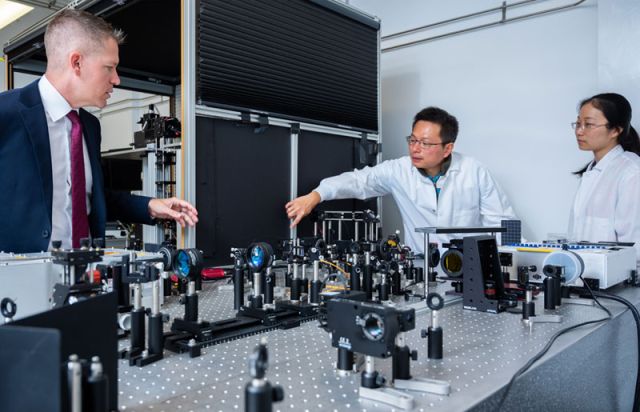
ECE Research Initiative
Spencer L. Smith, SLAB Neuroscience and Neuroengineering Lab | "New Frontiers of Computing with Neurons and Optics"
From The ECE Current Newsletter (Fall 2022)
ECE Professor Spencer LaVere Smith develops complex quantum mechanical imaging systems to precisely reverse engineer how the brain works
To uncover powerful principles of brain function, we need to measure neuron-resolution brain activity while the animals are doing something that they are experts at.
Modern artificial neural nets (ANNs) are a class of machine learning approaches that are inspired by the brain. ANNs are the leading approach for a range of problems including processing of image and video data, translating natural language, and navigation in self-driving cars and drones. Are there further insights into computation locked away in the brain? There must be, because even simple animals with small brains can outperform our best machines in some tasks. For example, mice can navigate complex worlds using vision alone, reliably and quickly, with rather poor image sensors (their tiny eyes) and a brain that runs on less than one watt of power. Spencer LaVere Smith’s research program is working to uncover new insights to computation in brains.
But there is a problem. The brain is very complex, and our tools for investigating it are limited. For example, brain activity imaging techniques are either low resolution, such as magnetic resonance imaging (MRI) which is related to blood flow or blood oxygenation, or high resolution like two-photon calcium imaging, but with only very small fields of view. So, there are two halves to the lab: half of the lab develops new tools and techniques, and the other half then uses these tools in neuroscience experiments to gain insights into computation in brains.
Most of the engineering is optical in nature, based on two-photon excitation of fluorescent proteins that are genetically engineered to report neural activity. Two-photon excitation is a quantum mechanical phenomenon, and depends on high power ultrafast lasers. The lab has pioneered large field-of-view two-photon imaging systems, which are high enough resolution to see individual neurons and synapses, with large enough fields of view to see multiple brain areas simultaneously. To examine the brain in action, the lab also develops virtual reality (VR) systems for mice. Mice show off their visual navigation skills while the lab images the brain activity underlying these feats. Next, sophisticated data analysis and modeling is used to gain insight into neural circuitry, and ultimately help create new and improved ANN technology.
Recently, the lab’s interest in computation and their expertise in optics have led to a new branch into optical computation. Von Neumann style computation is the fundamental design used in most computers, smartphones, and other computation devices we encounter. However, ANNs use computations that can be quite inefficient with this approach. Optics can be used to develop co-processors that offer improved speed and energy efficiency. For example, freespace optics offer a geometrically scalable approach for large fanouts, and Fourier transforms can be performed at the speed of light with very little energy usage, based on the physical principles of refractive lenses and interference within a coherent wavefront.
The ECE Current Newsletter (Fall 2022) "New Frontiers of Computing with Neurons and Optics" (pages 8-9)